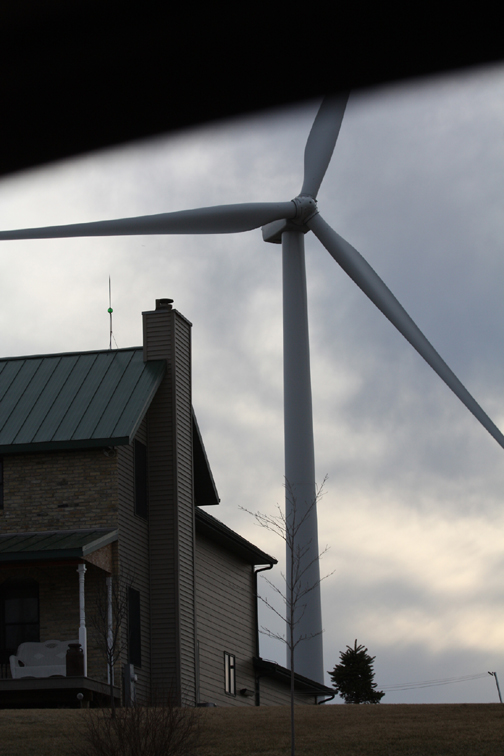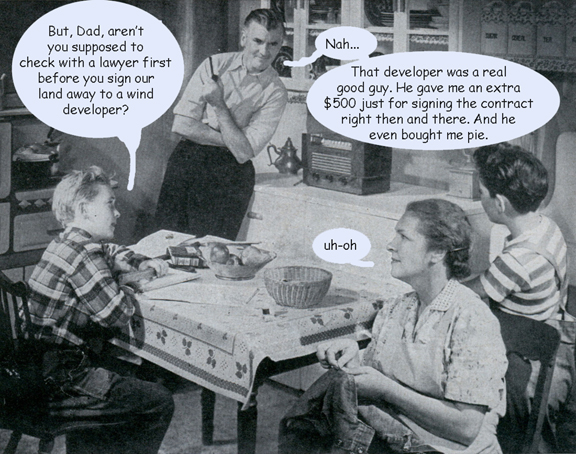How close can turbines be sited to your home? This is a recent photo from the Butler Ridge wind farm in Dodge County which went on line in February. Complaints about noise and shadow flicker from the turbines are already pouring in.
 Photo by Gerry Myer, April 2009
Photo by Gerry Myer, April 2009

Red Alert, Wisconsin
Note from the BPWI Research Nerd: Better Plan, Wisconsin urges you to contact your legislators as soon as you can and let them know that Senator Plale's Turbine Siting Reform bill will allow the PSC to approve the of siting of industrial scale wind turbines much too close to homes and sensitive wildlife habitat.
Though the bill mentions no specifics about setbacks, noise limits, and other siting concerns, it is very clear about giving turbine siting approval to the PSC.
The PSC approved the siting of turbines 1000 feet from non-participating residents homes, and a noise limit of 50 decibels. Families in the PSC approved wind farms of Fond du Lac and Dodge Counties are now having a hard time living with the disastrous results.
Please contact your legislators (click here to find out who they are and how to contact them) and let them know if they want wind turbine siting reform, it should be based it on the Town of Union's Large Wind Ordinance. The guidelines used by the PSC were provided by an out-of-state utility with a keen interest in siting as many turbines as possible in any given area, and no interest in protecting public health, safety, welfare, property values or wildlife.
(Click here to download the Union Ordinance)
Having trouble with turbine noise or shadow flicker? Want to get your story told? Contact us by clicking here. Better Plan, Wisconsin is ready to help!
 Of special interest to landowners and farmers: What AG Week has to say about contracts with wind developers:
Of special interest to landowners and farmers: What AG Week has to say about contracts with wind developers:
Dealing in wind
Matt Bewley, Agweek
Published: 04/13/2009
[Click here for source]
All the glitters is not gold, the saying goes. Take that wind turbine someone wants to install on your land. It will deliver energy; we know that. But will your wind energy contract deliver you the big bucks they say it will? Are you and your family protected in case of trouble? After all, this is a first-time deal for you; just one of many for the guy across the table, and he’s negotiating rights to your land for decades, not months.
This requires some forethought.
Development phase
Wind energy contracts lay out a span of time for the developers to get their turbine up and generating electricity. According to Roger McEowen, professor of agricultural law at Iowa State University in Ames, there needs to be protection for the landowner in case something goes wrong and the tower never goes up.
“Two to four years is adequate contract length for the development phase,” he says.
If it takes more time than that, the landowner must be free to move on to another developer, he says.
He also warns potential wind tower hosts to build relief against lowered yields into the contract in case any road building causes soil compaction or other problems in the fields. And it is a good idea to have the number of towers, their locations and the road plans presented early in the process so landowners have time to consider possible physical impediments to their operations, he says.
Industry experts recommend towers be built at least 1,300 feet from any houses for safety reasons, he says. He suggests that a mile or more would be better, considering possible nuisances such as noise and “shadow flicker,” which occurs when the sun passes behind the rotating blades.
Keep in mind also that the towers can be a nuisance to neighbors, he says.
Lease duration
Katharine Lusk is a “wind prospector” and specialist in landowner agreements.
“Typical leases are 30 to 50 years,” she says, adding that this is not unreasonable, considering the financial investment being made by developer.
A typical contract will set a base term of 15 to 20 years, after which renewal options are set at five-, 10- or 20-year increments. Lusk recommends landowners keep their options more flexible by utilizing shorter renewal periods as opposed to the 20-year renewals.
The wind energy company also should be required to provide at least six months’ notice before renewal, so the landowner has time to prepare for negotiations and that adjustments at renewal time should be allowed for in the contract.
She and McEowen both warn against long-term contracts.
“I once saw a contract for 180 years,” he says.
This ties up property and rights for several generations.
Lusk says even a 90-year contract is “ridiculous.”
Payment
Wind energy contracts can be structured around a number of payment types, including flat rates, payments per tower and royalty income, which pays a percentage of the proceeds the wind energy company receives from the sale of the electricity generated by the turbine.
Lusk recommends strongly against flat rate contracts over a period of years.
“If a company is wanting to do that, find another company,” she says.
McEowen says landowners should be clear, in the case of royalty payments, on the difference between kilowatt hours and megawatt hours. It should be based on gross revenue, he says, such that any increases in their operating costs are not passed on to the landowners.
“Keep in mind that the company is getting green credits and tax incentives,” he says. “The landowner should be able to share in that to some degree.”
He recommends getting a reasonable inflation rate built in, or landowners may soon find themselves losing large portions of their income.
“Long-term contracts are inherently biased toward developers,” he says. “Quite a few of the early ones had only 2 percent annual inflation adjustments. In 20 years, half the economic value is gone, and in 40 years, it is all gone.”
McEowen also cautions people with respect to the global and national economies and that it is possible that massive inflation is coming in the near future.
Other points to investigate are how “revenue” is defined in the contract, the timing of payments, impacts on taxes and what would happen if the land was put into or taken out of CRP.
Assignees
Long-term contracts, like mortgages, also are susceptible to assignment, or transfer to another company, which then would be responsible to the landowner for performance.
“Who are the potential assignees?” McEowen asks. “Get those assignee names up front so you have time to check them out.”
He contends that landowners should have a say in the choice.
“You don’t want to deal long-term with a company that pulls an Enron,” he says.
-------
Wind energy contract basics
- Get a list of and speak with landowners with whom they have worked.
- Add clause language to minimize impact by placement of the facilities.
- Add clause language to require removal of all equipment and improvements at the end of the contract.
- Never sign a wind energy contract without first having it reviewed by legal counsel.